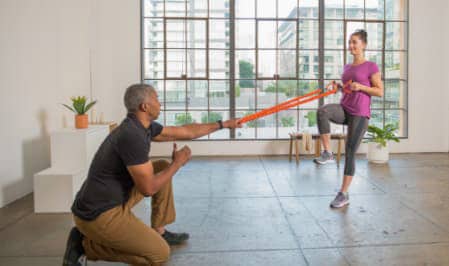Specializing in Corrective Exercise with NASM can stretch your earning potential along with your clients’ abilities to reduce the risk of injury—helping them move, feel and live better. Specializing in Corrective Exercise with NASM can stretch your earning potential along with your clients’ abilities to reduce the risk of injury—helping them move, feel and live better.
What You’ll Learn
You’ll learn how to assess clients in a whole new way It will help you better identify their movement compensations, where they are weak or strong, and hone your ability to use that knowledge to design effective and efficient programs.

Why Become a Corrective Exercise Specialist?
Help clients move better in every facet of their life
– Program more efficient and effective workouts
– Reach a wider group of potential clients and keep your current clients
– Help clients recover from workouts faster
– Help clients meet their fitness and movement goals more efficiently
– Expand your expertise while earning enough Continuing Education Units (CEUs) to recertify your Trainer Certification
Revolutionary Digital Learning Platform
Access NASM’s Corrective Exercise Specialization on a high-end, interactive digital learning platform that can be used anytime, anywhere, and on any device!
Take a quick tour below to get a firsthand look at the tools and features of this revolutionary platform.

Curriculum
Chapter 1: Rationale for Corrective Exercise
The student will understand the rationale and importance of delivering corrective exercise training to clients.
Chapter 2: Human Movement Science and Corrective Exercise
Discover the relationship between functional anatomy, the human movement system, and optimal movement and how this applies to the overall corrective exercise strategy.
Chapter 3: Inhibitory Techniques
Choose and implement the appropriate inhibitory strategies based on the current evidence gained from the assessments you’ve conducted.
Chapter 4: Lengthening Techniques
Learn the rationale and proper implementation of various flexibility modalities.
Chapter 5: Activation Techniques
Understand the guidelines, precautions, and contraindications for implementing isolated strengthening exercises.
Chapter 6: Integration Techniques
Understand the importance of integrated dynamic movement and how to progress these movements to reach your client’s performance goals.
Chapter 7: Client Intake and Assessment
Learn best practices for client intake and assessment to create the most targeted training program that addresses their specific needs.
Chapter 8: Static Assessments
Unlock the vital first step in the corrective exercise assessment process, which gives insight into the overall body alignment of the client.
Chapter 9: Movement Assessments
Movement assessments are the cornerstone of the assessment process. Work through the assessment flowchart, selecting the most relevant and targeted assessments.
Chapter 11: Corrective Strategies for the Foot and Ankle
Human movement is a complex balance of sensory stimulation, neuromuscular control, and biomechanical stabilization. At the root of human movement is the relationship between the foot and ankle. This chapter will review and explain the vital function of this aspect of the kinetic chain.
Chapter 12: Corrective Strategies for the Knee
Because the knee is so commonly injured, it is essential to know the kinetic function of this area of the body. You will learn the basic anatomy of the knee, strategies for treating it with corrective exercises, and how to identify abnormal muscle activation patterns.
Chapter 13: Corrective Strategies for the Lumbo-Pelvic-Hip Complex
The lumbo-pelvic-hip complex (LPHC) is a region of the body that has a massive influence on the structures above and below it. Because of this influence on neighboring muscles and joints, it's an incredibly important region to understand. The Corrective Exercise Specialist will learn how to ensure clients' LPHC are moving efficiently and safely.
Chapter 14: Corrective Strategies for the Thoracic Spine and Shoulder
This chapter will delve into the anatomy of the thoracic spine and shoulder, the mechanisms for common injuries in this region, the influence of altered thoracic spine movements on the kinetic chain, and more.
Chapter 15: Corrective Strategies for the Wrist and Elbow
The elbow joint functions as a link between the shoulder and wrist, providing a large amount of stability and motion. Given the complexity and necessity of the wrist and elbow, dysfunction can often be debilitating to normal activities of daily living. Within this chapter of the course, you will learn how to navigate this complex interplay between the wrist and elbow.
Chapter 16: Corrective Strategies for the Cervical Spine
This chapter will show you anatomy of the cervical spine, how to determine appropriate systematic assessment strategies for the cervical spine, how to select the appropriate strategies, and common injuries found in this region of the body.
Chapter 17: Self-Care and Recovery
Intense training and life stress can place unfamiliar demands on the body. Learn recovery strategies to mitigate the effects of these stressors on the body so that your clients can perform at an optimal level.
Chapter 18: Real-World Application of Corrective Exercise Strategies
Learn how to implement corrective exercise in a variety of scenarios and environments for clients with varying goals.
The Premium Self-Study package includes 16 audio lectures, 6 webinars, a suggested study schedule, and exam study guide.
Audio lectures:
- What is Regional Interdependence?
- Why Implement Corrective Exercise? What Does the Science Say?
- The Science Behind Flexibility and Self-Myofascial Techniques
- Motor Control, Motor Learning and Motor Development
- Optimal Length-Tension Relationships and Optimal Force
- Force-Couple Relationships
- Muscular/Movement Subsystems
- The Science of Inhibition Techniques
- The Science of Lengthening Techniques
- The Science of Activation Techniques
- The Science of Integration Techniques
- The Rationale for Dynamic Assessments
- Rest
- Refuel
- Regenerate
- Avoid Skipping Phases: Using all four phases of the Corrective Exercise Continuum
Webinars:
- Corrective Strategies for the Shoulder and Thoracic Spine
- Corrective Strategies for the LPHC
- Corrective Strategies for the Foot and Ankle
- Corrective Strategies for the Knee
- Corrective Strategies for Elbow and Wrist
- Corrective Strategies for Cervical Spine
After the completion of the course, you will take an online final exam from the comfort of your own home, or wherever you prefer to take tests, that consists of 100 questions. Each question will be multiple-choice. The exam is timed and cannot exceed 90 minutes. To pass, you need a score of 70% or higher. Don’t fret though, if you score below that, you have up to 3 attempts to pass.
Frequently Asked Questions
Corrective Exercise is a technique that addresses and fixes movement compensations. The goal is to improve the overall quality of movement during workouts and in everyday life. Read more about what Corrective Exercise is.
A Corrective Exercise Specialist is an expert in human movement. They accurately analyze a client's movement patterns, identify overactive and underactive muscle groups and compensations. People who hold a Corrective Exercise Specialization can work at a wide range of fitness facilities including gyms, health clubs, sports performance centers, recovery centers, healthcare offices and fitness studios. Read more about what a Corrective Exercise Specialist does and who should become an NASM-CES.
Once you pass your final exam, your NASM-CES specialization certificate never expires and does not require you to renew.
While a Personal Training Certification is suggested, it is not required to take the NASM-CES course. To participate, it is recommended you hold a CPT, accredited health or fitness certification, a 4-year college degree in a similar field, or be a current Certified Massage Therapist.
NASM-CES is approved for Continuing Education Units (CEUs) by the following organizations:
- NASM 1.9 CEU’s
- ACE 2.0 CEU’s
- 10 CIMSPA Endorsed CPD Points
- EREPS 10 ώρες μάθησης
Unfortunately, no. The CES exam is not available for a la carte purchase.
The course exam is available for 365 days from the date of enrollment.
The final exam is administered online within your student portal. It consists of 100 multiple-choice questions and 90 minutes for completion.

Who should become a NASM-CES?

NASM-CES provides personal trainers with the tools and resources needed to help their clients move better.

NASM-CES provides personal trainers with the tools and resources needed to help their clients move better.

Physiotherapists.Corrective exercise techniques can be used as a bridge to help patients progress from the treatment room to physical movement goals.

Chiropractors.Chiropractors can help clients move properly and participate in daily life and sports activities using corrective exercises.

Strength and Fitness Trainers.Strength and conditioning coaches can help clients improve their movement and increase their performance with training that targets strength and flexibility.










